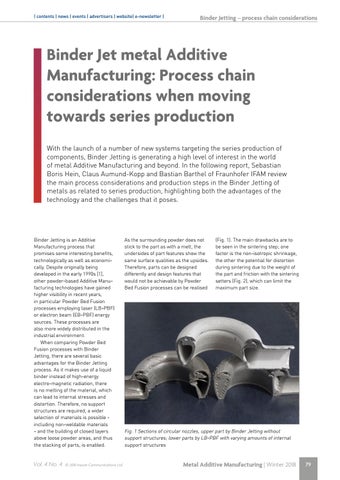| contents | news | events | advertisers | website| e-newsletter |
Binder Jetting – process chain considerations
Binder Jet metal Additive Manufacturing: Process chain considerations when moving towards series production With the launch of a number of new systems targeting the series production of components, Binder Jetting is generating a high level of interest in the world of metal Additive Manufacturing and beyond. In the following report, Sebastian Boris Hein, Claus Aumund-Kopp and Bastian Barthel of Fraunhofer IFAM review the main process considerations and production steps in the Binder Jetting of metals as related to series production, highlighting both the advantages of the technology and the challenges that it poses.
Binder Jetting is an Additive Manufacturing process that promises some interesting benefits, technologically as well as economically. Despite originally being developed in the early 1990s [1], other powder-based Additive Manufacturing technologies have gained higher visibility in recent years, in particular Powder Bed Fusion processes employing laser (LB-PBF) or electron beam (EB-PBF) energy sources. These processes are also more widely distributed in the industrial environment. When comparing Powder Bed Fusion processes with Binder Jetting, there are several basic advantages for the Binder Jetting process. As it makes use of a liquid binder instead of high-energy electro-magnetic radiation, there is no melting of the material, which can lead to internal stresses and distortion. Therefore, no support structures are required, a wider selection of materials is possible including non-weldable materials - and the building of closed layers above loose powder areas, and thus the stacking of parts, is enabled.
Vol. 4 No. 4 Š 2018 Inovar Communications Ltd
As the surrounding powder does not stick to the part as with a melt, the undersides of part features show the same surface qualities as the upsides. Therefore, parts can be designed differently and design features that would not be achievable by Powder Bed Fusion processes can be realised
(Fig. 1). The main drawbacks are to be seen in the sintering step; one factor is the non-isotropic shrinkage, the other the potential for distortion during sintering due to the weight of the part and friction with the sintering setters (Fig. 2), which can limit the maximum part size.
Fig. 1 Sections of circular nozzles, upper part by Binder Jetting without support structures; lower parts by LB-PBF with varying amounts of internal support structures
Metal Additive Manufacturing | Winter 2018
79
